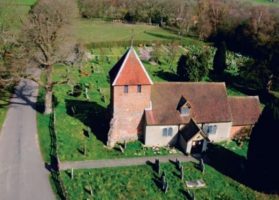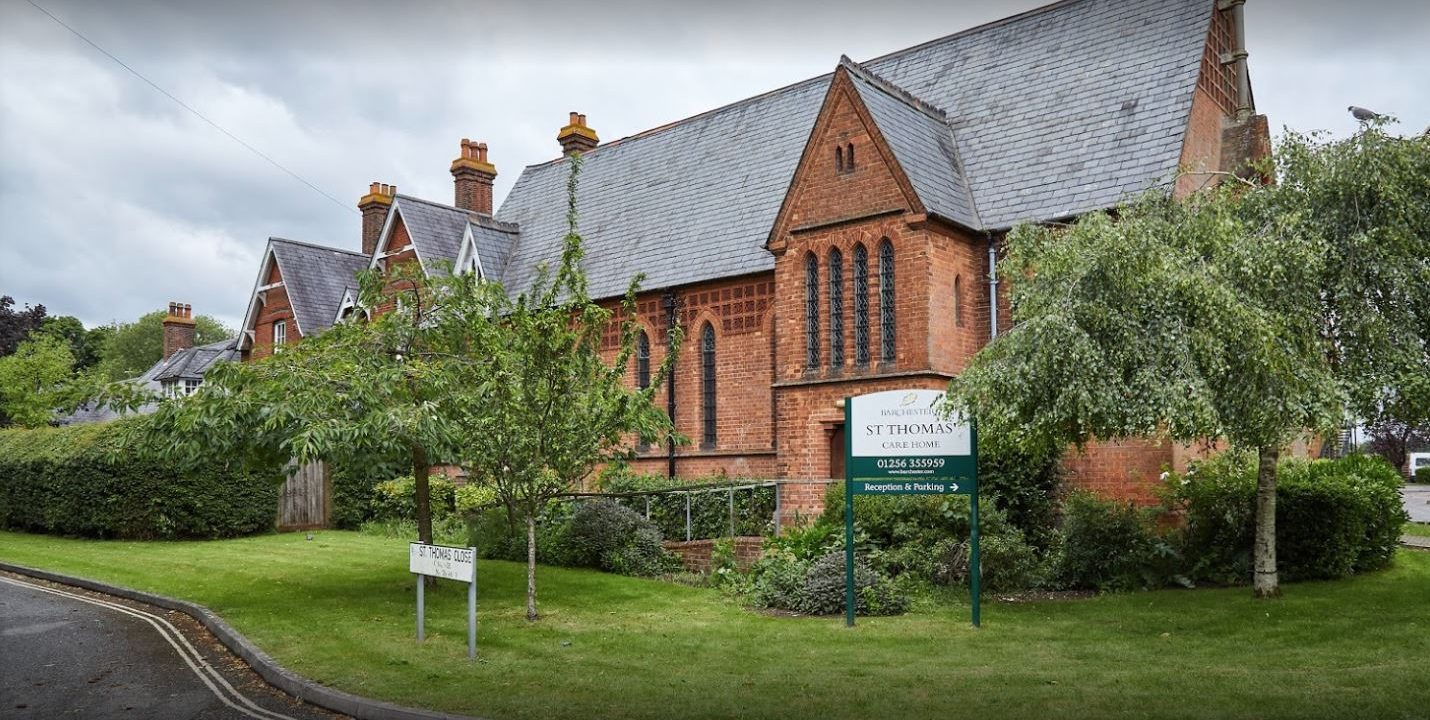TADS Newsletter April 2020
All previous TADS newsletters are available here
Basingstoke’s House for Fallen Women by John Fisher
This title conjures up all sorts of ideas and to have one in Basingstoke seems even more unlikely, but at the TADS Meeting in September 1990, Mr. John Fisher gave a very interesting account of just such a place.The house for fallen women, or St. Thomas’s, is a group of buildings, dating from the latter part of the Victorian era, situated to the north of Basingstoke station and was used as a rehabilitation centre for fallen and destitute women from about 1876 into the 1930’s.
The need for such a home was recognised around 1850 and eventually a house for about 14-20 women was established at Hardway in Hampshire around 1862, the women and girls coming from the areas of Portsmouth, Portsea and Gosport. (A receiving house was also established at Ash to take women from the Aldershot Camp area). The driving force for this venture was Admiral of the Fleet, Sir A.P. Ryder, KCB who gave his support from the first conception right up to the building of St. Thomas’s in Basingstoke.
Unfortunately the house at Hardway had to close due to lack of funds, and around 1867 the Reverend Lascelles, with the aid of Sister Harriot Hewitt, took over the home and under their leadership the home started to pay its way. Eventually the house proved to be too small and an appeal was made by another prominent figure, Bishop Wilberforce, to raise funds to increase the number of
women helped: “No Diocese in England so urgently needs such a provision as that which contains such centres of misery as those for which these refuges are provided. A most efficient council has been appointed to carry out this work, but large funds are urgently and immediately wanted.
Around 1874 Bishop Harold Brown purchased 3 acres at Basingstoke with the option of 2 more, and St. Thomas’s began to take shape. It took about 10 years to complete with much fund raising taking place during the building. Bishop Harold Brown’s appeal for funds stated: “There can be no work holier than Christ-like work than to rescue these women from misery and ruin and to bring back the fallen to penitence and purity”. St. Thomas’s took in about 70 women and entry was voluntary – but obviously preferable to the workhouse or the street. The women were expected to stay for 2 years and were schooled in the three Rs, laundry, baking, needlework and also singing. The women were housed in cottages rather than dormitories, a system recommended by Admiral Ryder.
The cost of keeping the women was £25 each per annum but the house took in work – laundry mainly – to help with the finances. The youngest were girls of 14 years and work in service was found for all women and girls at the end of their stay. In a comment on the younger girls, which shows that thought and effort went into looking after the women and children, the Reverend Bigwither said: “If we receive a child at 14 and send her out to service at 16, we dismiss her at a most dangerous age. At such an age the reaction from the 2 years restraint issues in too frequently in an abuse of regained liberty.
Experience shows that these children need a term of at least 3 to 4 years of supervision of some kind.” In January 1868. after the death of Sister Hariot Hewitt and the resignation due to ill health, of Dr. Millard, the first Warden, the Sisterhood of St. Thomas the Martyr at Oxford, took on the responsibility of the Home. The buildings form a quadrangle and the last building to be completed was the Chapel. ‘This was designed by the Architect, Sir Henry Woodyear in 1884 and is a Grade 2 listed building. There is also a fountain in the centre of the quadrangle, presented by Admiral Ryder.
St.Thomas’s was used by the Education Authority until about 1985 but is now becoming derelict – the present occupiers being the Security Guards – but it has a special place in the history of Basingstoke due to the fact that such rehabilitation facilities of that period must be of a unique nature.
Bert Rogers (1990)
PostScript
We received the following question from Social media: “I’ve recently read your article about the St Thomas Home and wonder if you can advise if there are any records available regarding individuals who were admitted there? I’m keen to find out more about my 2nd Great Aunt, who was there in 1881“.
Answer: The best option to provide information on your Great Aunt might be the book with the longest title ever: “History of the Foundation and of the Chief Incidents in the gradual establishment of St. Thomas’ Home, Basingstoke, the Winchester Diocesan Penitentiary for Friendless and Fallen Women, with a chapter concerning the penitents and the sermons preached at the laying of the foundation stone and dedication of the chapel : Illustrated with photographs and plans.”by Bigg-Wither, Reginald Fitz Hugh, b.1842. The book can be found in both the Winchester Archives and the Hartley Library at Southampton University [1] John Fisher has written an article, published in the Hampshire Magazine and is presently writing another.
The history of St Thomas’s Diocesan Home for the Friendless and Fallen ,Basingstoke [2] was written by the warden, the Rev Reginald Fitzhugh Biggs Wither, who lived in Darlington Road in the warden’s house from at least 1880 to 1895 The Bigg-Wither family home was at Manydown and it was Reginald’s grandfather, Harris Bigg-Wither (1781-1833) who had proposed to and been accepted by Jane Austen.
It was Admiral Ryder[3] who had the idea for establishing a diocesan home for women from Portsmouth, Portsea and Gosport. He was a member of the Church of England Purity Society and in 1883 delivered a paper at Reading entitled ‘The Purity and Prevention of the Degradation of Women and Children.’ [4] It was thought that essentially places of refuge where the women could live and work and not return to their families would be a solution – a place where young women whose lives had been ruined by prostitution or abuse could come to live and work.
In January 1863 the Bishop of Winchester gave his approval to the project to build a home at Basingstoke, chosen for its distance from Portsmouth and for its closeness to the railway. In 1874 a site of 3 acres was accepted in Basingstoke with option to buy 2 more acres @ £250 per acre. The seller was John Burgess Soper, who had acquired the land from the May Brothers in 1867. It was to offer to women:- “the chance of recovering the character they have lost before God and society”
The home gave the women accommodation and work as laundresses, taking in laundry from the town. They were not allowed to go home, or, if they did, they would not be re-admitted to St Thomas’s. Often their mothers would plead for them to go home and help with the care of their younger siblings, but it was known that if they did, the cycle of abuse and the income from prostitution would lead them into their former lives. The history of the home, written by its second warden, the Rev Reginald Bigg-Wither, contains heart-rending letters written by women whose lives had been changed by their stay in St Thomas’s.
By 1885 there were 60 penitents in the home plus servants, workers and sisters. The site was described thus: [5] Admiral Sir Alfred Phillips Ryder (1820-1888) Admiral of the Fleet, KCB. Commander in Chief, Portsmouth. He had been interested in this welfare work since 1850. The whole site of five acres, admirably placed upon the crown of a hill, eight minutes’ walk from Basingstoke Station, (with all its railway facilities), well supplied with water for garden and Laundry purposes, with a view extending from 5 to 25 miles in every direction, was surrounded partly by a wall, (given by Sir E Hulse) partly by a high fence of oak and fir.
Moreover by an additional loan of £375 from Admiral Ryder, a suitable Gardener’s Cottage or Lodge was built at the entrance gate of the “Home” grounds.” …. “600 or 700 trees and shrubs” were planted. In July 1884, work began on a new chapel designed by Henry Woodyer, a well-known architect and a follower of Pugin. (He also designed St Thomas of Canterbury at Worting). The chapel was dedicated by the Bishop of Winchester on July 21 1885, the eve of St Mary Magdalen’s feast day [6] (she is, of course, the patron saint of ‘fallen’ women). Women who were taken in at St Thomas’s had to stay for two years and would be trained in laundry and dairy work, cooking and needlework as well as doing some basic studying.
The women, many of whom were very young, lived in cottages with a house mother. Two of the sisters who worked at St Thomas’s, Sister Rachel and Sister Harriet, worked there until their deaths from overwork and it is reputed to be the ghost of Sister Harriet, a lady in grey, who haunts the present day nursing home.[7]
The 1930 OS map calls St Thomas’s the Mount Tabor Certified Institution, which was a different kind of home, sheltering people under the terms of the 1913 Mental Deficiency Act [8], but precisely when the diocesan home closed and Mt Tabor opened I don’t know. It’s interesting that Terry Hunt’s photos of the chapel are labelled by him as the Chapel at Mt Tabor and although his photos are sadly undated they will probably not be later than the mid-1930s as his obituary noted that he had been ill for 8 or 9 years before his death in 1949. The Hampshire Record Office has references to Mount Tabor as being the home of the Congregation of the Sisters of the Transfiguration (an Anglican order) run under the auspices of the Winchester Diocesan Union for Preventive and Rescue Work.[9] In 1951 St Thomas’s got its old name back as the School for the Deaf which occupied the site until it was closed in the mid-1980s.
After that the premises were used as a night-shelter for the homeless but suffered some vandalism and fires. When the complex of buildings was threatened with demolition for redevelopment in 1989, a group of local people led by the redoubtable Jean Miller, who lived opposite the home, fought a huge battle to save it and achieved statutory Grade II* listing for the chapel and were eventually able to resist Hampshire County Council’s intention to demolish the rest of the complex of buildings. Now, as St Thomas’s Care Home, run by Barchester Healthcare, it has a new and useful life.
The St Thomas Diocesan Home for the Friendless and Fallen in the Diocese of Winchester established in 1864 had five Refuges, and was soon to add another soon add another. He said that some were very expensive and all were entirely unremunerative. Refuges, while they add incalculably to the efficiency of the Diocesan machinery, add largely to the total expenditure, and therefore considerably to the net cost per penitent. When complete there will be accommodation for about 80 patients.
In no single instance had a girl been reported as dismissed, either at her own request or for misconduct, from St. Thomas’ during the year 1882, to which year the Report refers. To the kindly influence of the Warden and the Sisters this gratifying fact was to be attributed. The Ladies’ Associations in different parts of the Diocese of Winchester work heartily for the twin objects of Prevention and Rescue. The statutes of St. Thomas’ Home have been enlarged so as to include Preventive work. So satisfactory were the results of the work at Basingstoke, that the Diocese of Chester has obtained copies of the designs of St Thomas* Home, and proposes to build on the same (cottage) principle.
It appears that 76 girls were received at St. Thomas’ in 1882, and that in addition to these, the three Refuges at Portsmouth, Gosport, and Aldershot rescued 112, or 188 in all, of whom 17 were confirmed. The Report for 1882 gives the average daily number of girls housed as 34 in the Home and 7 in the Refuges. The gross annual cost per penitent housed (including the expenditure on Refugees) was 52 7s., and it would appear that the net cost apportioned among the daily average number of girls housed, viz., 41, is ;£38, [the Report for 1883 shows a considerable reduction], also, if apportioned among the cases considered ” satisfactory” on leaving (viz., the 29 penitents who have gone to service, or to friends, or married), is £54 7s.
It is to be hoped that the Council of St. Thomas’ Home which is a Diocesan Institution will promptly take steps to become the Executive of the Branch of the Church of England Purity Society in the Diocese of Winchester, as it has been invited to do (through the Bishop) by the Council of the Church of England Purity Society.[55]
Timeline of St Thomas’ Diocesan Home for the Friendless and Fallen [2]
1874 Site of 3 acres accepted in Basingstoke with option to buy 2 more acres @ £250 per acre
1878 Two new cottages begun and completed – whole site 5 acres
1878 Gardener’s cottage – now the Lodge 1879 foundation stone
1884 July 22nd “foundation of chapel for 100 persons designed by the well-known Church Architect, Mr Woodyer, was laid by Mrs Harold Browne ….”
1885 60 penitents in the home plus servants workers and sisters
“ The whole site of five acres, admirably placed upon the crown of a hill, eight minutes’ walk from Basingstoke Station, (with all its railway facilities,) well supplied with water for garden and Laundry purposes, with a view extending from 5 to 25 miles in every direction, was surrounded partly by a wall, (given by Sir E Hulse) partly by a high fence of oak and fir. Moreover by an additional loan of £375 from Admiral Ryder, a suitable Gardener’s Cottage or Lodge was built at the entrance gate of the “Home” grounds.” …. “600 or 700 trees and shrubs” were planted.”
1907 Fire damaged building (there is a Terry Hunt photo of this)
1951 St Thomas’ School for the Deaf established
1993 Site developed for housing. Chapel saved. In between was used as a night shelter for the homeless. Rumours of haunting, Lynden Jones (head of deaf school) said thought to be a ‘grey lady’ believed to have died in the 1907 fire, but no-one was killed. Perhaps Sister Harriet – the first sister in charge.
References:
[1] HRO, History of the Foundation and of the chief incidents in the gradual Establishment of St Thomas’ Home, Basingstoke, the Winchester Diocesan penitentiary for Friendless and Fallen Women, with a chapter concerning the penitents. Printed and Published by Jacob, C J , Winchester Street, Basingstoke and Simpkin, Marshall and Co., Stationers’ Hall Court, London. Publication Information: Cambridge : Chadwyck-Healey Ltd., 2000. Physical Description: 1 microfiche ; 11×15 cm. Series: The Nineteenth Century. General Collection ; title no. N.1.1.12422 Series Title: The Nineteenth Century. General Collection ; title no. N.1.1.12422 General Note: Copyright receipt stamp dated 1887. – At foot of cover-title: By Rev. R.F. Bigg-Wither Warden. – Cover-title reads: History of St. Thomas’ Home The Winchester Diocesan Penitentiary. Original imprint: Basingstoke : printed and published by C.J. Jacob, Winchester Street. London: Simpkin, Marshall, and Co., Stationers’ Hall Court. , [1887]; London. Format: Hartley Library 19th Century Microfiche Reference:
872289-1001
[2] St_Thomas_timeline_and_history_jb_edit.pdf
[3] A_short_History_of_South_View.pdf
[4] Appendix VII. of “A Paper on “purity and the Prevention of the Degradation of Women and Children ” by Admiral Sir Alfred Phillips Ryder
[5] Admiral Sir Alfred Phillips Ryder (1820-1888) Admiral of the Fleet, KCB. Commander in Chief, Portsmouth. He had been interested in this welfare work since 1850.
[6] Fisher, John Hampshire Magazine August 1988 p.55
[7] Ibid p.57
[8] It seems likely that it continued to operate a laundry as Miss Muriel and Edith Pink, who lived from childhood in Richmond Road recalled the laundry being taken to and fro by horse and cart. They moved to Richmond Road in about 1926.
[9] HRO100M97/C1/1


